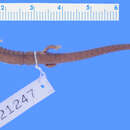Description
provided by AmphibiaWeb articles
Nototriton barbouri display a snout truncate that is broadly rounded in the dorsal aspect, and a lateral profile that is truncate to mostly rounded. The nostril openings are small and when viewed from below, the protuberant eyes are narrowly visible beyond the margin of the jaw. Males exhibit well developed labial protuberances, while it is weakly developed in females of this species. In breeding condition, males may display an oval-shaped mental gland cluster. A shallow postorbital grove extends posteriorly from the eye, and connects to the gular fold. Another sharp ventral groove is present just posterior to the lower jaw. Males possess marginally larger numbers of maxillary and volmerine teeth while females display slightly more premaxillary teeth than males. The tail is slightly constricted at the base. The anterior cross section is nearly rectangular, and the distal one-third of the tail becomes ovoid. N. barbouri exhibit slender, and short limbs. The tips of the toes display well developed subdigital pads and are bluntly rounded. This species may be differentiated from Cryptotriton nasalis and Dendrotriton sanctibarbarus by its relatively small nostril openings and undersized limbs. N. barbouri is larger than N. lignicola and possesses a longer tail. It is also distinguished from N. limnospectator by having relatively larger nostril openings and a wider head. The relatively narrow feet and characteristic sublingual fold help recognize N. barbouri from the remaining Honduran salamander in the same genus. In alcohol, the dorsal and lateral surfaces may be observed to be pale to dark brown to black. The ventral surfaces may be slightly more pale brown than the dorsal surfaces. Cream flecking may or may not be present.This account was based on the species account from McCranie and Wilson (2002) .
Distribution and Habitat
provided by AmphibiaWeb articles
N. barbouri is mostly found in the Premontane West Forest and Lower Montane Wet Forest formations at elevations of 860-1990 m in Honduras.
Life History, Abundance, Activity, and Special Behaviors
provided by AmphibiaWeb articles
Observed clutch sizes of eggs have ranged from 5-19 eggs.
Nototriton barbouri: Brief Summary
provided by wikipedia EN
Nototriton barbouri is a species of salamander in the family Plethodontidae. It is endemic to Honduras.
Its natural habitats are subtropical or tropical moist lowland forests and subtropical or tropical moist montane forests. It is threatened by habitat loss.
The Nototriton barbouri is often referred to by its common name, the Yoro Moss Salamander. N. Barbouri's habitat includes packed leaf litter, rotten logs, abandoned hummingbird nests, and inside bromeliads during the daytime. At nighttime, they actively forage on the branches of small trees and shrubs (J. Townsend, 2016).
- license
- cc-by-sa-3.0
- copyright
- Wikipedia authors and editors

